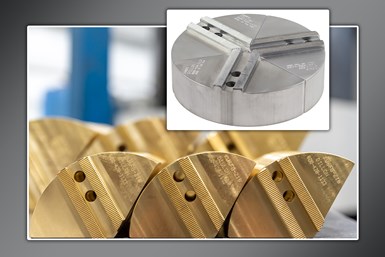Dillon's Full-Grip Chuck Jaws Reduce Part Distortion
Dillon Full-Grip Jaws are ideal for high-speed machining, as well as precision boring, tapping, drilling and finishing across most industrial markets.
Share




Dillon Manufacturing’s line of full-grip jaws are available in various materials in both standard and custom configurations to suit varied workholding applications.
With maximum contact area for a solid gripping surface, these full-grip jaws are said to provide more friction for drive with reduced part distortion. Manufactured from 6061 aluminum, 1018 steel, cast iron and brass, Dillon Full-Grip Jaws will not mark or mar the workpiece surface. Standard sizes are available to up 32" in diameter. Custom designs available with special heights, diameters, materials and configuration can securely grip any workpiece, including a matching serration location which is exactly perpendicular to the slots. In addition, these special full-grip jaws can reduce and simplify set-up times. Dillon says its full-grip chuck jaws are made in the U.S. with industry-leading lead times. They are ideal for high-speed machining, as well as precision boring, tapping, drilling and finishing across most industrial markets.
These wrap-around type top jaws distribute more of the gripping pressure across the workpiece, reducing part distortion. Dillon standard and custom full-grip jaws are available in serrated, tongue and groove serrated, Acme serrated and square serrated designs.
Related Content
-
Prioritizing Workholding Density Versus Simplicity
Determining whether to use high-density fixtures or to simplify workholding requires a deeper look into the details of your parts and processes.
-
Using Automation to Reduce COGS and Stay Globally Competitive
Decade-long, multiphase automation investments lower operating costs and maintain technology lead in an increasingly competitive global market.
-
Lean Approach to Automated Machine Tending Delivers Quicker Paths to Success
Almost any shop can automate at least some of its production, even in low-volume, high-mix applications. The key to getting started is finding the simplest solutions that fit your requirements. It helps to work with an automation partner that understands your needs.





















.jpg;maxWidth=300;quality=90)

